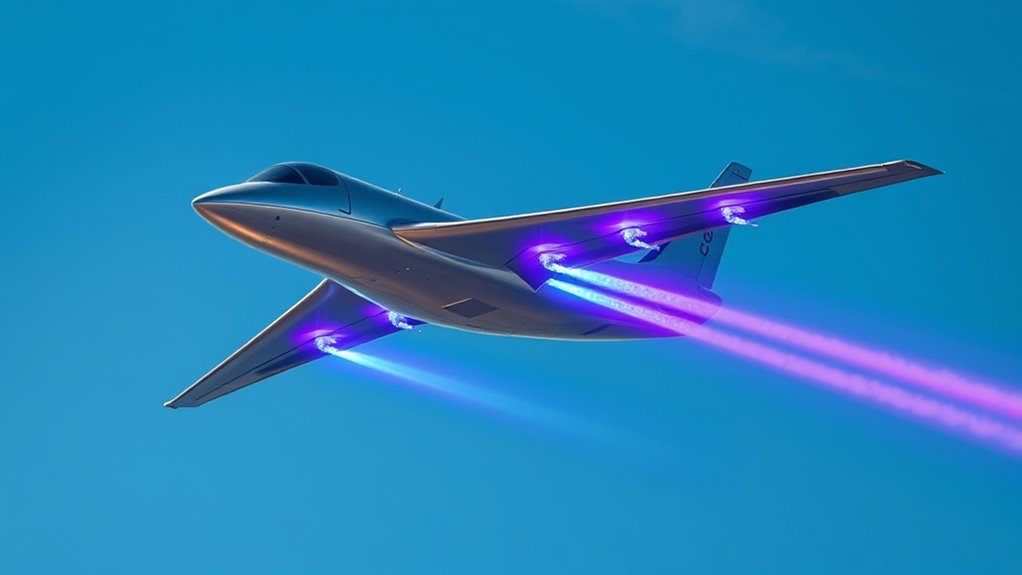Plasma propulsion uses microwave energy to ionize and heat atmospheric air, creating thrust without combustion. This technology offers a cleaner, quieter way to power planes, reducing emissions and noise. Prototype engines show promising thrust-to-power ratios, indicating potential for scalable, efficient travel solutions. Although challenges remain, especially in energy storage, ongoing research aims to bring this innovative propulsion closer to commercial reality. Keep exploring to discover how plasma propulsion could reshape future air travel.
Key Takeaways
- Plasma propulsion uses microwave energy to ionize air, providing thrust without combustion or carbon emissions.
- Laboratory prototypes have demonstrated promising thrust-to-power ratios suitable for scalable aircraft propulsion.
- This technology offers quieter, cleaner, and more efficient alternatives to traditional jet engines for commercial flights.
- Challenges include improving energy storage, power source density, and microwave energy efficiency for larger aircraft.
- Continued research aims to integrate plasma propulsion into commercial aviation, enhancing sustainability and environmental impact.

As the aviation industry seeks cleaner, quieter, and more efficient propulsion methods, plasma propulsion emerges as a promising contender for future commercial air travel. Unlike traditional engines that burn fossil fuels, plasma propulsion uses microwave energy to ionize and heat compressed atmospheric air, creating thrust without emissions. In lab tests, prototype plasma engines have demonstrated 11 Newtons of thrust from just 400 watts of microwave power. About 4 Newtons come from the pressure of the compressed air, with the remaining thrust generated by energized plasma. This results in a thrust-to-power ratio of roughly 28 Newtons per kilowatt, a promising figure for future scaling. The process involves drawing in air, compressing it, then passing it through a quartz chamber where microwave energy ionizes the air, heating it to over 1,000°C. Rapid expansion of this superheated plasma produces thrust, mimicking the operation of conventional jet engines but without combustion or carbon emissions. Additionally, ongoing research into energy density aims to address the current limitations of battery technology that hinder larger-scale applications.
Frequently Asked Questions
What Are the Safety Concerns Associated With Plasma Propulsion Systems?
You should be aware that plasma propulsion systems pose safety concerns like electromagnetic interference that can disrupt onboard electronics. High voltages and energetic plasma streams increase risks of electrical arcs and malfunctions. Overheating and material erosion can degrade components, while handling reactive gases adds potential hazards. Additionally, high-capacity batteries risk overheating or thermal runaway, which could lead to fires or system failures. Proper shielding, thermal management, and robust control systems are essential for safety.
How Does Plasma Propulsion Compare Cost-Wise to Traditional Jet Engines?
You wonder how plasma propulsion stacks up financially. It involves higher initial costs due to R&D, infrastructure upgrades, and new manufacturing processes. While operational costs could drop thanks to fuel efficiency and electric power, you’ll face expenses for high-power systems, advanced energy sources, and airport modifications. Though promising long-term savings, the upfront investment remains significant, making the overall cost comparison complex but potentially advantageous over time.
What Are the Environmental Impacts of Plasma-Based Aircraft?
You’re wondering about the environmental impacts of plasma-based aircraft. This technology produces zero carbon emissions, reducing greenhouse gases considerably. It also operates quieter and with fewer pollutants like NOx, soot, and hydrocarbons. Using ambient air and electricity means less environmental harm from fuel extraction and combustion. Overall, plasma propulsion offers a cleaner, quieter, and more sustainable alternative, helping you cut your aircraft’s ecological footprint and support global warming mitigation efforts.
How Soon Could Plasma Propulsion Realistically Be Implemented Commercially?
You’re curious about how soon plasma propulsion could become commercial. Right now, the technology is still in research stages, mainly tested in space applications. For aircraft, significant challenges like scaling, system integration, and safety need addressing. Experts estimate it could take several decades before plasma propulsion is viable for commercial planes, with near-term efforts focusing on hybrid systems to improve efficiency and reduce emissions. Full implementation remains a long-term goal.
Are There Any Existing Prototypes or Experimental Aircraft Using Plasma Propulsion?
You’re asking if any prototypes or experimental aircraft are using plasma propulsion. Currently, researchers like Wuhan University have developed plasma jet thrusters that ionize air with microwaves, demonstrating small-scale lifting capabilities. These prototypes are tested in labs or on scaled models, but none are flying in real-world conditions yet. While promising, further advancements in power systems, materials, and heat management are needed before plasma propulsion can be used in full-sized aircraft.
Conclusion
So, as you imagine flying smoother and greener, it’s funny how plasma propulsion might just be the unexpected twist in your next trip. You never thought that a tiny spark could power huge jets, right? It’s like finding out your favorite gadget has a secret superpower. The future’s closer than you think, and with plasma technology, your flights could become not just faster, but way more eco-friendly. Who knew innovation could feel so familiar?










